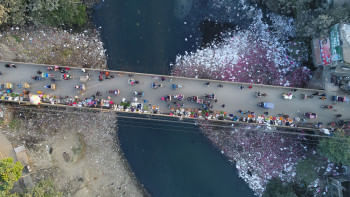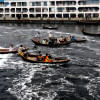Save Bhairab River before it’s too late

It is frustrating to see how most of our rivers are struggling to survive due to the mindless activities of land grabbers, sand lifters and polluters. Equally frustrating is how sometimes state officials responsible for rivers are themselves complicit in such activities, in the name of development. One such river is Bhairab, which flows through Khulna and Jashore in the southwestern part of Bangladesh. According to a report by this daily, the river is on its deathbed due to encroachment, pollution, unplanned river dredging, and bridge construction works. Consequently, it has shrunk so much over the years that, in many places, it looks rather like a canal. The resultant loss of navigability has also contributed to a livelihood crisis for thousands of people in the region.
Reportedly, there are hundreds of business establishments including factories, depots and industrial units—both legal and illegal—on both sides of the river. Waste generated from these establishments as well as nearby households is regularly discharged into the river. Moreover, over 300 cargo vessels carrying goods and oil from Jashore's Noapara to different parts of the country every day pollute it by discharging chemicals. At least 20 large drains under the Khulna City Corporation also directly discharge liquid waste into the river. The construction of hundreds of illegal structures on riverbanks have also shrunk it significantly. We must ask: is there no one to stop this massive onslaught?
While we often blame the polluters and grabbers for the tragic fate of our rivers, we seem to ignore the fact that unplanned development activities, such as constructing random bridges and culverts, are also causing them to shrink. Across Noapara, a total of 51 bridges and culverts constructed on the Bhairab River were reportedly not planned properly. If this is the condition of one river in one area, imagine how bad the situation is across the country.
It's saddening how—despite so many government pledges, court directives, billions spent in river projects, and the awarding of a "living entities" status to rivers—very little has been achieved in terms of protecting our rivers. Bhairab is just one victim of the authorities' failure. We urge the BIWTA and other relevant authorities to stop the polluters and grabbers, and undertake proper measures to increase its navigability. We must save this river and others facing a similar fate for our own sake.


 For all latest news, follow The Daily Star's Google News channel.
For all latest news, follow The Daily Star's Google News channel. 










Comments